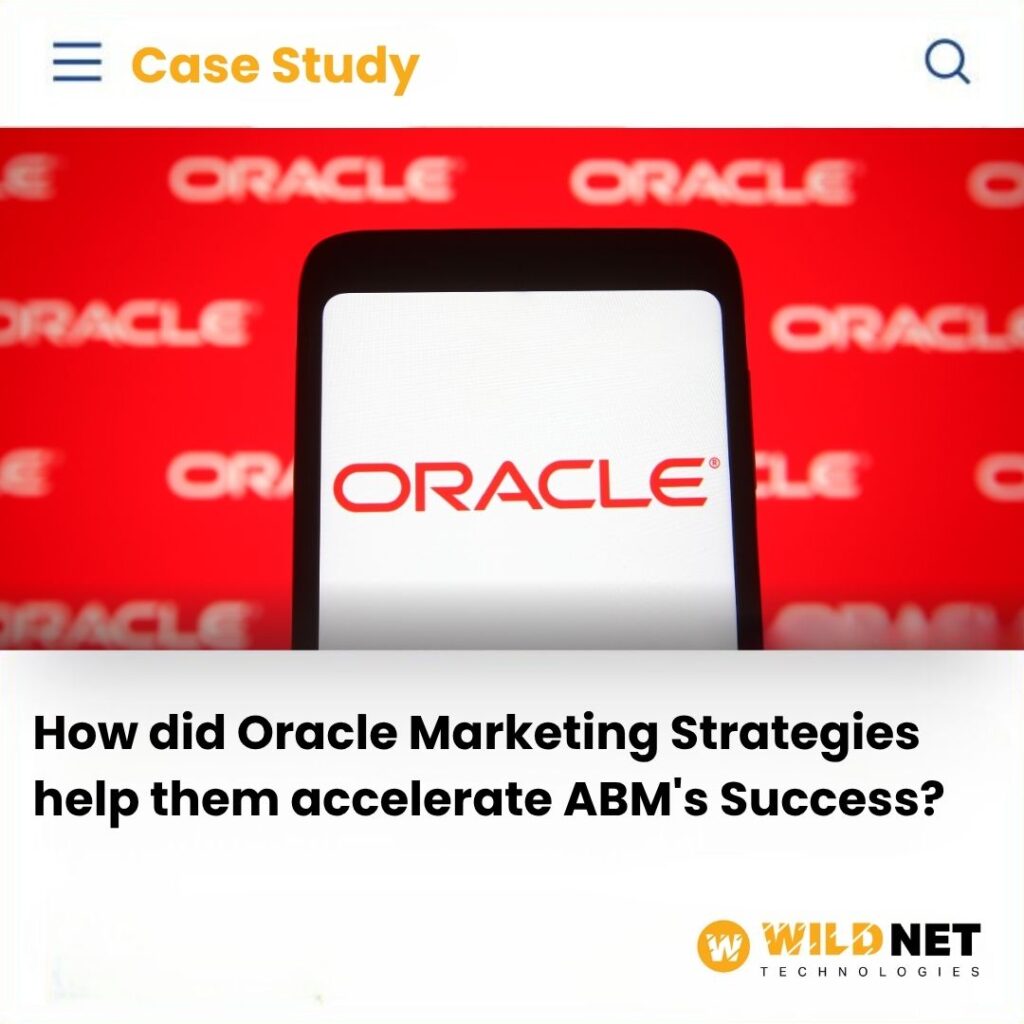In today’s competitive B2B landscape, traditional marketing methods often fall short in delivering the personalized experiences that modern enterprise buyers demand.
Recognizing this shift, Oracle strategically pivoted towards Account-Based Marketing (ABM), leveraging advanced data-driven insights and targeted content.
This accelerated engagement and streamlined sales processes that helped them achieve substantial growth.
Wildnet’s case study highlights Oracle’s transformative approach, detailing the Oracle marketing strategies and tools employed to overcome marketing challenges & achieve exceptional results through ABM.
Fig 1: A graphical representation denoting the difference between Traditional vs ABM. [Source: Gartner]
Business Overview
Oracle is a global leader in cloud computing and enterprise software.
It was established in 1977 and since then has catered to 4.3 lakh clients in 175 countries.
It empowers organizations to unlock innovation, drive growth, and enhance efficiency.
With a diverse suite of technologies, Oracle serves multiple industries, providing solutions in database management, cloud infrastructure, marketing automation, analytics, and application software.
To keep up with the evolving digital landscape, Oracle Marketing Strategies are innovated to stay competitive and relevant in the dynamic B2B market.
Challenges
Oracle faced several critical marketing challenges:
Fragmented Data & Disjointed Marketing Efforts
Data silos across departments limited the ability to create unified customer profiles.
Low Engagement Rates
Traditional mass-marketing methods yielded limited interaction and engagement from targeted accounts.
Limited Sales & Marketing Alignment
Disconnected objectives between sales and marketing teams hindered efficient collaboration & lead conversions.
Inadequate Personalization
Generic messaging did not resonate effectively with diverse customer segments.
Slow Deal Progression
Lengthy sales cycles required a more targeted and personalized marketing approach to accelerate conversions.
Difficulty Scaling Marketing Efforts
Oracle struggled to scale highly personalized marketing campaigns effectively across numerous global accounts.
With so many challenges in sight, Oracle Marketing Strategies had to bring out something out of the ordinary to remain useful in 2025 and beyond.
Solutions
They addressed these challenges using comprehensive and integrated Oracle marketing strategies.
We share with you the Oracle marketing strategies list so that you can choose what works best for your company.
Oracle Content Marketing
They created highly personalized and engaging content tailored to individual customer personas & buying stages.
Goals for Oracle Content Marketing
Here are some of the goals that Oracle defined precisely.
- Shares
- Followers
- Traffic
Along with some key goals for account-based marketing,
- Pipeline Velocity
- Lead Generation
- Revenue
This significantly increased their relevance and user engagement.
Oracle Product Marketing
They leveraged insights into product-specific needs to create targeted campaigns that effectively communicated product value propositions.
Account-Based Marketing (ABM)
Oracle adopted a strategic ABM framework segmented into three sectors.
Fig 2: A graphical representation of the three types of ABM.
One-to-One
They selected one to five client accounts and catered to their needs via hyper-targeted Oracle marketing strategies.
One-to-Few
Oracle grouped customer profiles for a segment while keeping in mind ideal buyer personas.
Then, tailored marketing campaigns were run for them.
One-to-Many
Using CRM of customer relationship management software and/or marketing automation tools, their marketing team grouped various accounts.
Based on the industries, the content personalization was carried out while keeping in mind the company sizes, features and expertise.
It helped them in ensuring precision targeting and tailored messaging for high-value accounts.
Digital Marketing Strategies
The company integrated multi-channel approaches, including
- email marketing,
- LinkedIn ads,
- executive events,
- direct mail, and
- programmatic display advertising.
Oracle did this to ensure cohesive messaging and robust customer engagement across all touchpoints.
Oracle Marketing Automation & Analytics
They utilized Oracle Eloqua, Oracle Unity, and Oracle CX Marketing.
And it helped them to
- automate & streamline processes,
- unify data,
- provide Oracle Marketing Analytics in real-time, and
- ensure seamless campaign orchestration & sales alignment.
So, Oracle Marketing Strategies leveraged all they had to cater to the whole world and thus covered a vast variety of demands, specifications, customization & more.
Steps to Achieve Sales & Marketing Alignment in Your Business
Fig 3: A cyclic representation of the steps that Sales Team (on the left) and Marketing Team (on the right) can follow for perfect alignment.
Below we have mentioned how marketers can achieve this alignment and work as one.
Ø High-quality content creation and management for easy sales
Ø Sales team upskilling on how marketing campaigns work
Ø Trustworthy lead scoring system and sending only high-quality leads to the sales department.
While the sales team can follow the below-mentioned points to do their part and build synchronicity.
Ø Working on the leads in a timely manner
Ø Communicate the gaps highlighted by the clients
Ø Be transparent with the lead cycle and closure along with valid reasons.
If any brand’s sales and marketing teams follow these three rules, then they can achieve similar alignment as done via Oracle Marketing Strategies.
Results
The implementation of evolved Oracle Marketing Strategies delivered significant improvements.
Key ones are listed below.
40% increase
Oracle Marketing Strategies resulted in a 40% boost in the Marketing Qualified Accounts (MQAs), which indicated enhanced targeting efficiency.
30% reduction
A 30% reduction was seen in time-to-conversion from Marketing Qualified Leads (MQLs) to Sales Qualified Leads (SQLs) due to Oracle Marketing Strategies, indicating faster sales cycles.
25% increase
While a 25% boost was witnessed in average deal size from ABM-targeted accounts, driven by highly tailored content and personalized engagements all because of the ever-changing Oracle Marketing Strategies.
Improved customer experience (CX)
Enhanced user satisfaction was seen due to highly relevant and timely communication as well as engagements.
Accurate measurement of CX was possible via Oracle Marketing Strategies through increased interactions and feedback.
Steps to Achieve Quick Results from Your Business’s ABM
If your brand knows the steps to follow and achieve ABM success, then no hurdle will come in its way.
Fig 4: A step-by-step approach to ABM success.
Here they are,
- Sales & Marketing Alignment
- Defining, Identifying & Prioritizing target accounts
- Content Plan (Prospects to Web Experience)
- Paid Ads to cover more ground (read: search results)
- Content Syndication or Omnichannel Marketing
- Nurture Business Relationships
We know it can look difficult at first, but with the right digital marketing partner by your side, anything and everything is possible.
Conclusion
Oracle’s strategic integration of content marketing, product marketing, and various types of digital marketing channels robustly & significantly accelerated their ABM success.
By unifying data, personalizing content, and aligning sales & marketing strategies, Oracle transformed its approach to B2B marketing.
It resulted in increased engagement, faster conversions, and measurable growth.
Through these cohesive Oracle marketing strategies, they not only achieved immediate business outcomes but also positioned themselves as a benchmark.
The Oracle ABM case study is a great example of innovative and effective enterprise marketing.
If you want your brand to evolve with the AI era of 2025, leverage Wildnet’s AI-powered digital marketing services like content marketing, product marketing and ABM services.



